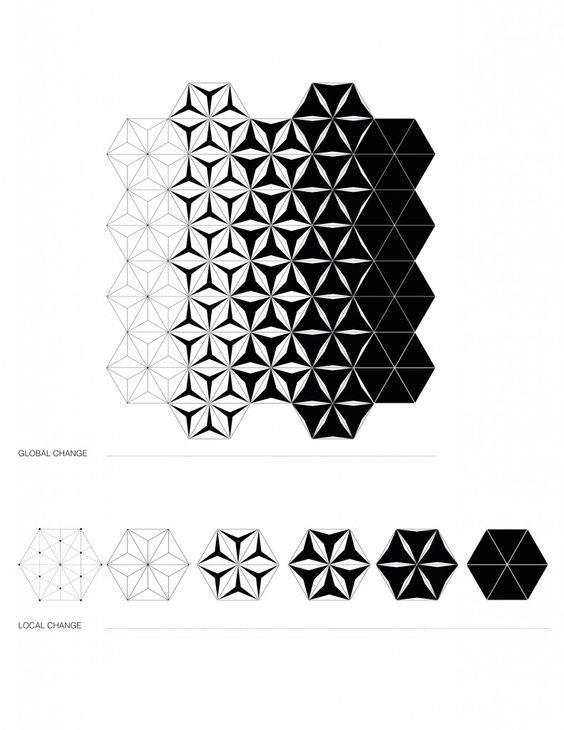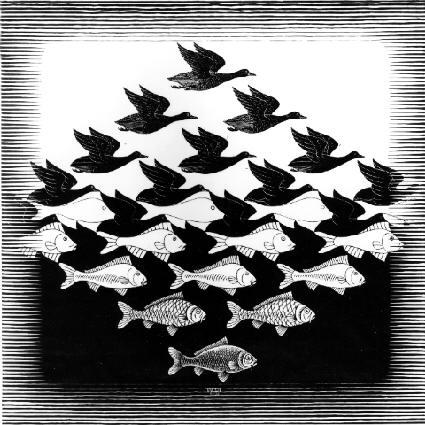Introduction
As a researcher, I am fascinated by Escher’s unique vision of shapes and patterns. My core idea is to adopt some of the artist’s approaches to the creation of my own work where the shape undergoes gradual metamorphoses as if evolving. In fact, the point of my work is to show the development of shape in the Islamic art. In order to achieve my goal, I am presenting this research that covers multiple aspects of my project. First of all, the paper will discuss the artist and his biography, style, and techniques. Further, the description will move on to the connection between the methodology of his work and the final results. Finally, the subject of my research and the proposal will be explained in detail.
Research
The model for this research is Maurits Cornelis Escher, one of the most well-known graphic artists in the world. His style is often characterized using such terms as “impossible constructions” and echoing patterns (M.C. Escher, 2016; M.C. Escher Biography, 2016). The artist was born in the Netherlands in 1898, and since childhood has shown a unique ability to notice and visualize patterns (M.C. Escher Biography, 2016). Traveling around the world and familiarizing himself with the arts of various cultures and era, Escher has formed his individual approach and style combining math and ornaments, creating mesmerizing collaborations of shapes forming into complex and multidimensional patterns.
M.C. Escher was a graphic artist who practiced a multitude of ways of self-expression including wood and linoleum carving, print making, tessellation, lithography, and mezotints. His works were based on the exploration of infinity, complex symmetry and reflection, bizarre geometrical forms; besides, he has several human- and nature-oriented works such as portraits, landscapes, and plants. Escher cannot be referred to any of the known movements in art.
Escher’s diverse works were created with the help of versatile materials, tools and appliances. Throughout different periods of this work, the artist used ink, pencils, chalk, paint, and watercolors. Some of his masterpieces were wood engravings and carvings, etchings, and linoleum cuts. His techniques for image making were based on the precise and sharp lines, contrasting colors, and clear edges. As a result, his works demonstrated the levels of reality merging into one another without becoming blurry or vague. This feature adds the uniqueness to the works of Escher who managed to portray the surreal making it rather realistic.
The examples of the Islamic patterns that will be used as inspiration for the project and the works of Escher are presented in the text. The current discussions of Escher’s works explore the transition that is an ever-present attribute of all the works of this artist (Poole, 2015). Based on my personal observations, the most fascinating aspect of the transitions in his works is their precision that indicates Escher’s artistic bravery and willingness to take the risky way of making the impossible look realistic and adding metamorphoses to the still art works. The importance of Escher’s works lies in their timelessness, and this is the characteristic I would like to make the key feature of my project.
Subject
M.C. Escher is an artist whose work is mostly based on patterns. This is why I chose him to guide and inspire me in my passionate interest in patterns and textures. I wanted to take my work into a different direction from what I normally explore. Escher’s work is very strong because he uses very powerful and unusual techniques that manipulate the eye and have an effective way of playing with elements that are transformed through his drawings. I would like to explore the way in which M.C Escher’s works with the transformation of the forms. I would like to apply it into Islamic patterns.
As I am very interested in textures and patterns and I would like to use Islamic artwork to transfer these slowly from their basic geometric shapes into a complete shape. It will be useful to show how the process that Islamic patterns go through. This is how Escher works; he gradually changes the figure into different shapes until it became a different form. It is a very interesting and accomplished technique, but I will focus on through the surfaces of an Islamic element instead of figures.

The subject I plan to explore in my project is not limited by the shapes of the old Islamic patterns and ornaments solely. I believe that this project has a deeper meaning as it attempts to capture the beauty and power of change, one of the most natural attributes of each of our world’s dimensions. The primary theme of my project is transformation that will be portrayed in detail reflecting new and new features step by step.
That way, I intend to portray the inevitability of change and its effect on the pattern in general as the addition of every small detail will lead to the metamorphoses of the whole composition. Also, the fact that I focus on the Islamic patterns, the legacy of one of the oldest cultures in the world, allows me to incorporate the transitions made within this culture over time as a symbol of how Islam has grown and developed throughout the history producing a powerful influence on its community and the societies around.

Besides, I believe that in the contemporary world shaken by negative stereotypes about Islam and the phenomenon known as Islamophobia, it is highly important to point out the aspects of this culture that represent beauty, aesthetics, appreciation of art and the amazing cultural and historical background. Raising such subjects, I, as an artist, make my contribution to the education of my audience about what the Islamic culture stands for apart from all the negative perceptions.

In fact, in my opinion, this work and its theme would be useful for the viewers who come from the Islamic culture and those who do not. The former will have a chance to re-connect with their legacy and appreciate how deep, old, and meaningful their history and art are; and the latter will discover new sides of the culture they might have never known about.

Project Exploration
The strategy that I am aiming to work on is the same used in Eschars work which is transforming the figure slowly throughout the page; I will start by doing some research to find out how the Islamic geometrical patterns changed in terms of time, scale, accuracy, and style. I also plan to incorporate color in order to enhance the change.
After collecting the information needed I will start by drawing from the left side of the page an old basic geometry that will be in order until the most advanced geometry it will be transformed through the page gradually I would like to explore the expansion and development of geometry from the very beginning onward, I will fabricate the element slowly and smoothly to reach the next element in row, which I believe it will be very challenging but nothing imposable.
As for the materials that I am planning to use will be the black bolded ink in a long horizontal paper. In my opinion, Escher’s technique represents an outstanding approach to transformation that solves a complex issue of capturing the changes in shapes at every single stage of their evolution. This is the technique I would like to make the core of my project demonstrating the metamorphosis of the shapes within the Islamic patterns and incorporating the changes they have undergone through the course of the history in the sharp and contrasted drawing. Just like Escher’s metamorphoses reflected the levels of reality merging with one another, I think the evolution of the Islamic pattern could become an interesting allegory for the changes the Islamic culture has experienced over time and the ones it is facing currently.
Putting my ideas into practice, I plan to review the works of Escher comparing their symmetric and transitional patterns into the ornaments of the Islamic architecture and the changes they have undergone. That way, my individual pattern will begin with one type of shape that will gradually transform into a completely different one with more complexity and a different color. The transition will be sharp, yet smooth, happening one step at a time by means of the addition of a few new details that will gradually lead to the radical change of the initial shape. All in all, the final work will be a reflection of the evolving culture both in artistic and socio-cultural aspects. In terms of the artistic approach, it will incorporate the techniques developed and applied by Escher adjusted to my own project and style but preserving the uniqueness of the pattern. The final work is intended to look as a complex combination of shapes transitioning into one another accompanied by the contrasting change in both pattern and color.
To me, this project is extremely fascinating it terms of aesthetics, and the technical approach. I would like to capture the change in the architectural ornaments and patters showing their smooth development as a symbol and a reflection of the development of the whole society and culture that stood behind the art.
Conclusion
Shape plays a vital role in the individual expressions of artists. A shape can be still or vivid, constant or transforming, plain or vibrant. The organization of shape, its creation, and integration in a work is the main focus of the present research that is based on the masterpieces of a well-known Dutch artist Maurits Cornelis Escher. This artist and his works were chosen as my guidance and inspiration for this research. The masterpieces of Escher are very significant in terms of shape and its development and capacities. Through his works, the artist has demonstrated that as still as a shape can be on canvas, it can be given some unusual properties and meanings.
Using the patterns and techniques practiced and developed by M.C. Escher, I intend to demonstrate multiple ideas: first of all, I would like to show the timelessness and the universality of the application of the artist’s approach and perspective; secondly, I would like to provide a detailed demonstration of the metamorphoses the Islamic patterns have undergone throughout time; thirdly, I intend to use this project as an educational and inspirations artwork for the audiences of both Islamic and non-Islamic backgrounds to appreciate the culture I explore. Finally, for me as an artist, this project is an interesting challenge with a complex practical side which I will have to work on to achieve a smooth, yet, contrasting transition and the unique beauty the work as a whole with its symmetry, complexity, and captivated movement.
References
M.C. Escher. (2016). Biography.
M.C. Escher Biography. (2016). Web.
Poole, S. (2015). The impossible world of MC Escher. Web.
Evolution of Islamic geometric patterns. (2013). Web.
M.C. Escher. (n.d.)